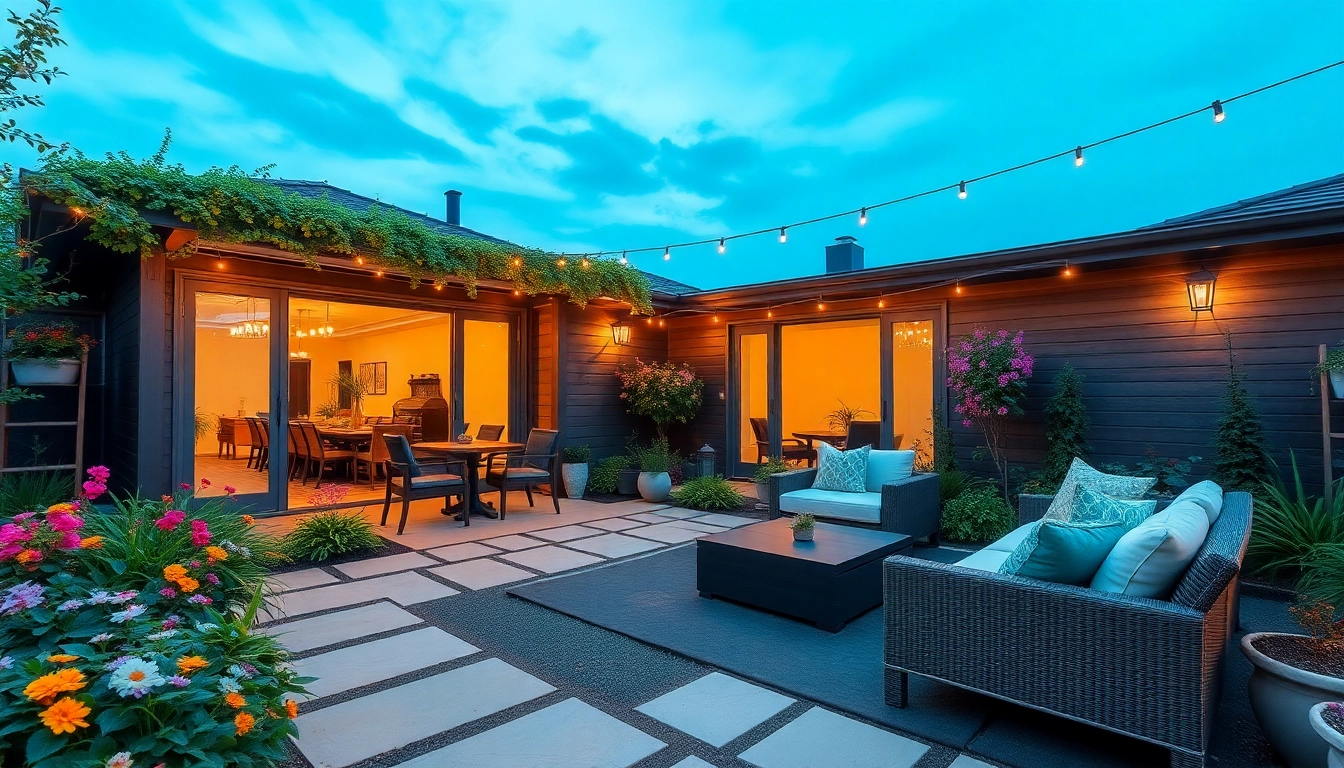
Enhancing Your Outdoor Oasis: Expert Landscape Design Service for Every Home
Understanding Landscape Design Services
What is Landscape Design?
Landscape design is the art and science of integrating nature and functionality into outdoor spaces. It encompasses a variety of disciplines such as horticulture, garden design, architecture, and environmental stewardship. Landscape designers work meticulously to create cohesive and aesthetically pleasing environments that harmonize with the natural surroundings. Whether for residential properties, commercial spaces, or public parks, effective landscape design considers the characteristics of the land, the climate, and the needs of the users.
Benefits of Professional Landscape Design Services
Engaging a professional landscape design service can transform an ordinary yard into an extraordinary outdoor space. There are several benefits to seeking professional expertise:
- Enhanced Aesthetics: A skilled designer can create visually stunning landscapes that enhance the beauty of your property.
- Increased Property Value: Well-designed landscapes can increase a property’s market value by up to 15%, making it a worthwhile investment.
- Functional Outdoor Spaces: Professional designers can tailor outdoor spaces to meet specific needs, from entertaining to relaxation.
- Sustainability: Experts stay updated on eco-friendly practices and sustainable materials, helping conserve resources and promote biodiversity.
- Time and Cost Efficiency: Hiring professionals can save time and potentially reduce costs through effective planning and execution.
Key Elements of Landscape Design
A successful landscape design incorporates various elements that work synergistically to create a harmonious outdoor environment. These include:
- Plants: Trees, shrubs, flowers, and grasses selected for their suitability to the climate and aesthetic appeal.
- Hardscapes: Structures such as patios, pathways, and retaining walls that add functionality and define spaces.
- Water Features: Elements like ponds, fountains, and streams enhance visual interest and provide a calming ambiance.
- Lighting: Appropriate illumination enhances safety and extends the usability of the space into the evening hours.
- Soil and Drainage: Healthy soil and efficient drainage systems are critical to supporting plants and maintaining landscape integrity.
Choosing the Right Landscape Design Service
Factors to Consider When Selecting a Service
When choosing a landscape design service, several factors should influence your decision-making process:
- Experience: Look for services with a proven track record in the industry and a portfolio showcasing their previous projects.
- Specialization: Some designers specialize in residential, commercial, or specific styles such as modern, traditional, or xeriscape.
- Approach: Understand their design philosophy – do they prioritize sustainability and current trends, or do they bring classic designs to life?
- Communication: Effective communication is vital for understanding your vision and translating it into a suitable design.
Assessing Expertise and Portfolio
Reviewing a landscape designer’s portfolio allows you to assess their expertise and approach. Look for a variety of projects that demonstrate versatility and creativity, as well as designs that align with your style preferences. Additionally, inquire about their educational background and any certifications that validate their professionalism in landscape architecture and design.
Client Reviews and Testimonials
Client feedback is invaluable in selecting the right landscape designer. Read reviews on various platforms and consider reaching out to past clients to gauge their satisfaction. Positive recommendations typically indicate a reliable service that can translate visions into reality while minimizing headaches during execution.
Landscape Design Trends to Consider
Sustainable and Eco-Friendly Designs
As the world becomes increasingly aware of environmental issues, sustainability has become a cornerstone of modern landscape design. Eco-friendly practices include:
- Xeriscaping: This approach focuses on drought-tolerant plants and minimizes water use, making gardens more resilient to changing climate conditions.
- Native Plant Usage: Incorporating plants that are native to the region helps promote local ecosystems and decreases the need for fertilizers and pesticides.
- Permeable Surfaces: Using materials that allow water to soak through can reduce runoff and lessen the impact on local waterways.
Incorporating Smart Technology in Landscape Design Services
Innovation in landscaping has led to the rise of smart technology. Automated irrigation systems, smart lighting, and weather-responsive management systems can optimize your landscape’s maintenance and enhance its functionality:
For instance, smart irrigation systems reduce water waste by adjusting watering schedules based on weather patterns. Similarly, smart lighting can provide energy savings and enhance safety by adjusting based on time of day or when motion is detected.
Classic vs. Contemporary Landscape Styles
Landscape design is a reflection of personal taste, and styles can range from classic to contemporary:
- Classic Designs: Incorporating traditional elements such as topiary, formal gardens, and wrought iron elements provides timeless elegance.
- Contemporary Designs: These designs focus on minimalism, using clean lines, modern materials, and a limited plant palette to create striking and functional spaces.
Finding the right balance between personal style and current trends can lead to a unique and fulfilling outdoor environment.
Steps in the Landscape Design Process
Initial Consultation and Site Analysis
The journey of transforming a landscape begins with an initial consultation. During this meeting, you should share your vision, preferences, and budget. The designer will conduct a thorough site analysis, examining factors such as:
- Topography and soil conditions
- Existing vegetation and structures
- Light and shade conditions
- Drainage and water flow issues
This analysis is crucial for creating a design that is both beautiful and functional while addressing any potential problems.
Design Proposal and Client Approval
Once your landscape designer gathers the necessary information, they will create a design proposal. This typically includes:
- Concept drawings
- Plant and material selections
- Cost estimates
- Maintenance recommendations
Client feedback is vital at this stage, and adjustments can be made to ensure the design reflects your vision while remaining within budget.
Implementation and Project Completion
With an approved design in hand, the next phase is implementation. This involves coordinating the various elements of the project, from sourcing plants to hiring contractors for hardscape installations. Professional landscape services often manage this process, ensuring quality and adherence to the design plans.
Once the project is implemented, the designer should conduct a walkthrough to ensure all elements meet your expectations. A successful handover often includes maintenance guidance to help your new landscape thrive.
Cost Considerations for Landscape Design Services
Understanding Pricing Models
Landscape design services can vary widely in cost, often influenced by the complexity of the project, geographical location, and specific service offerings. Pricing models may include:
- Hourly Rates: Many landscape designers charge hourly fees, typically ranging from $50 to $150, based on expertise and market conditions.
- Flat Fees: For specific services or small projects, a flat fee might be more appropriate, allowing clients to know upfront what to expect financially.
- Percentage of Project Costs: Some designers charge a percentage of the total installation costs, commonly between 10% to 20%.
Average Costs for Different Projects
The total cost associated with landscaping projects can differ significantly based on scope. Here’s a general breakdown:
- Small garden redesign: $1,500 – $3,000
- Complete yard overhaul: $5,000 – $15,000
- Commercial site landscaping: $15,000 – $50,000+
Geographic location also plays a critical role; costs may be higher in metropolitan areas compared to rural settings.
Budgeting for Long-Term Maintenance
Creating an inviting outdoor space requires regular maintenance to sustain its beauty and functionality. Consider budgeting for:
- Professional maintenance services (mowing, pruning, etc.)
- Seasonal plant replacements and mulching
- irrigation repair and upkeep
Annual maintenance costs can average between 5% to 15% of the original installation costs, depending on the landscape complexity and your level of involvement.
